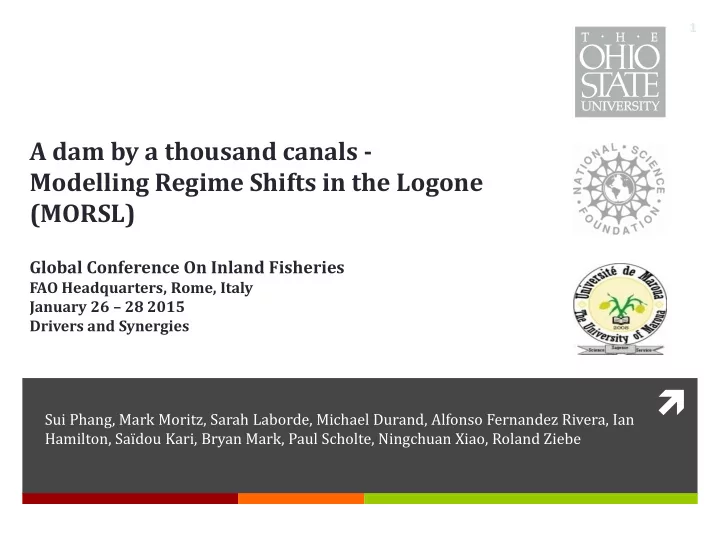

1 A dam by a thousand canals - Modelling Regime Shifts in the Logone (MORSL) Global Conference On Inland Fisheries FAO Headquarters, Rome, Italy January 26 – 28 2015 Drivers and Synergies Sui Phang, Mark Moritz, Sarah Laborde, Michael Durand, Alfonso Fernandez Rivera, Ian Hamilton, Saïdou Kari, Bryan Mark, Paul Scholte, Ningchuan Xiao, Roland Ziebe
Logone floodplain
Flooding history N 1. 1977 (Benech 1982) 2. 1993 (Sighomnou 1997) 3. 2014 (Nasa 2014) 1. Natural (pre 1979) 2. Maga dam (1979 - 1994) 3. Reflooding scheme (1994 – ) 20km Month of the year
Floodplain productivity - Floodplain productivity is extremely high in the wet season which is contrasted against the conditions during the dry season. - The periodicity and the large differences between the seasons is an important factor to understand drivers of fisher decisions.
Canals i Fishing canals are dug by fishers during the dry season and towards the end of the flood recession, structures at the mouth of the canal trap fish (i) and funnel them into the net (ii). The technique is iii highlyeffective and non - specific in the fish they catch. ii Over 400kg of fish can be caught in a period of 24 hours (iii).
Canal growth Fishing canals are seen as the most productive fishing technique their numbers have grown exponentially.
Canal distribution - Canals are significant features that can span several metres in depth and width and be over a kilometer long. -Their spatial distribution is not confined to a specific area.
Canal effects Canals potentially impact all sectors of the Coupled Human and Natural System (CHANs); our project looks at defining these linkages and their associated resulting impacts. Impacts are cross- sectorial and also potentially compromise fish stocks.
Drivers Environment Resource Growth Social status - Disparity in demand - Increase in - Canals are seen - Movement seasonal population as a premium productivity away from non- numbers commodity and communal means that canal owners fishers look to fishing methods can support a maximise wet to individual larger family catch season harvest ‘Social Lack of contagion’ - People want alternatives - Canal catch is canals because Canal construction the greatest per they can see capita technique their productivity
Synergies Mitigate canal impacts Synergies with Maga dam water Physical environment pastoralists release - Modify current - Identify potential - Work with Maga dam practices that maintain synergies between management to create a high productivity but allochthonous inputs flow regime within the minimise floodwater from pastoralists (i.e. river channel network drainage (e.g. cattle dung) and fish that reduces canal alternative drainage production impacts on floodplain regimes) drainage Information dissemination - Utilise the same network that spread canals as the premium fishing technique to implement any synergestic or impact mitigation ideas.
A rapidly changing context Environmental change • Shrinking Lake Chad • Climate change • Logone flood management along the Chadian bank • Economic change • Oil exploration on the floodplain • Social change • Social instability (i.e. Boko Haram) affecting economic and • social drivers for local communities
12 Canals = dam? One large disturbance or … an accumulation of small changes Pictures Google Earth Maga Dam A thousand canals
13 13 Acknowledgements Collaborators : Rebecca Garabed, Reza Najafi Research assistants : Oumarou Kari, Haman Wabi, Sali Siddiki, and CARPA personnel. Students : Yu-Jen Chen, Jessica Healy, Paul Maddock, Emily Nosse-Leirer, Brandon Mohr, Nathaniel Henry. Research permits and support : Ministère de la Recherche Scientifique et de l’Innovation, Ecole de Faune de Garoua, Maroua University, and Centre d’Appui a la Recherche et au Pastoralisme (CARPA). Financial support: Department of Anthropology and College of Social and Behavioral Sciences at the Ohio State University, National Science Foundation (BCS-1211986). Thanks: All the people in the Logone Floodplain of Cameroon .
mlab.osu.edu/morsl 2014 Profile Picture Winner Anthropology and Environment Society Photo credit: Sarah Laborde
Recommend
More recommend